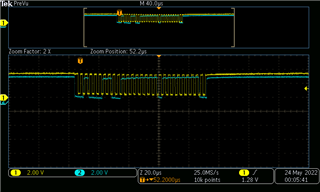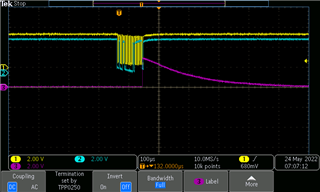Other Parts Discussed in Thread: TCA9535,
We have a design with eight PCF8575 all connected to an I2C interface. All devices are to being used as outputs. We are using an FPGA to generate the SCL and SDA signals. I do believe that the I2C signals are correct as if I use a correct address, I get an ACK. If I purposely set the the upper fixed portion of the address to something other than "0100" then I get a NACK. Each of the 8 devices is hardwired "000" to "111".
I've attached a screenshot of a scope capture of the I2C signals right at the input pins of one of the 8575 ic's.
The issue we have is that if I try to set an output high the voltage level is really low, ~125mV. If I set it low, voltage reads 0 from volt meter.
Any suggestions?


